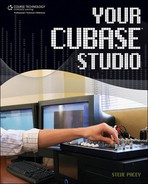Exporting a Final Stereo Mix
When your mix is sounding as good as it possibly can, you’re ready for the final export.
Exporting a mix is no different from exporting a MIDI track to an audio file, or bouncing an audio track with effects. There are only a few changes in the Export window that you should consider when making the final export.
You don’t need to export your mix to the project folder, but keeping your mixes in the project folder may make them easier to find later on.
There are several file formats to choose from when exporting. Using WAV64 files may be something you should seriously consider if you plan on having your mix professionally mastered as they are becoming more and more of a standardized format. If this is the case, you should speak to the person in charge of mastering your CD and ask about preferred formats.
Even though CDs play at 44.1 kHz and use 16-bit technology, using higher sample rates and bit depths during recording has been proven to increase sound quality. Even if your project was recorded at a lower bit depth and sample rate, upgrading those for your final mix will make a big difference in the sound. If your intention is to create a CD afterward, you can use a process called dithering to convert your mix to match a CD’s specs.
Using real-time export will be slower but will most likely provide better results than not using it because sometimes certain plug-ins and instruments react with glitches or errors during the speedy export process. Slower processing almost always means more accurate processing.
Unless you’re exporting your final mix at the same bit depth and sample rate as your project, you should most likely leave the import options (Pool and Audio Track) unchecked. If these are checked, you will be forced to change the bit depth and sample rate of the imported file.
Another reason to use real-time export is you can watch your output meter and make sure that there aren’t any peaks in the red while the song is playing from start to finish. Any peak during the export will result in audio clipping and will create digital distortion in the final mix. Even if the digital distortion is inaudible, it can create problems for you down the road.
Exporting a mix is easy. Once your mix is created, you should be able to play it back on any device or program that plays the file format you selected during the export procedure. Always save your project after you have finished a mix. It’s a good idea to include the date of the mix in the name of the project so you know exactly which version you’re pulling up. You may find yourself coming back to a mix for remixing later.
Again, I believe that the way I’ve shown you to mix in Cubase is becoming more and more of a universal standard and using a virtual mixer or an external control surface in some ways is like taking a step backward. If, however, you are used to using a mixer and this new way seems inferior to you, please take the time to explore using Cubase’s mixer as it should provide more of an old-school approach to mixing. You can find many more details on Cubase’s mixer within the Cubase manual.
